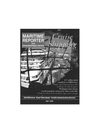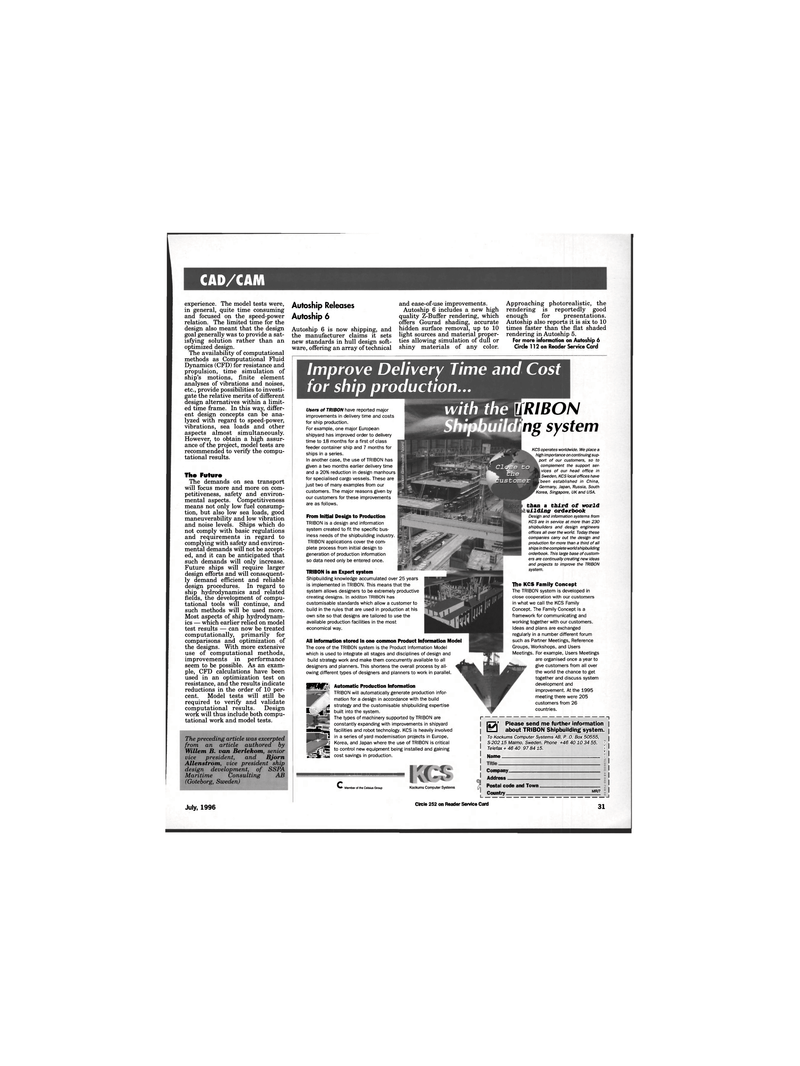
Page 29: of Maritime Reporter Magazine (July 1996)
Read this page in Pdf, Flash or Html5 edition of July 1996 Maritime Reporter Magazine
CAD/CAM experience. The model tests were, in general, quite time consuming and focused on the speed-power relation. The limited time for the design also meant that the design goal generally was to provide a sat- isfying solution rather than an optimized design.
The availability of computational methods as Computational Fluid
Dynamics (CFD) for resistance and propulsion, time simulation of ship's motions, finite element analyses of vibrations and noises, etc., provide possibilities to investi- gate the relative merits of different design alternatives within a limit- ed time frame. In this way, differ- ent design concepts can be ana- lyzed with regard to speed-power, vibrations, sea loads and other aspects almost simultaneously.
However, to obtain a high assur- ance of the project, model tests are recommended to verify the compu- tational results.
The Future
The demands on sea transport will focus more and more on com- petitiveness, safety and environ- mental aspects. Competitiveness means not only low fuel consump- tion, but also low sea loads, good maneuverability and low vibration and noise levels. Ships which do not comply with basic regulations and requirements in regard to complying with safety and environ- mental demands will not be accept- ed, and it can be anticipated that such demands will only increase.
Future ships will require larger design efforts and will consequent- ly demand efficient and reliable design procedures. In regard to ship hydrodynamics and related fields, the development of compu- tational tools will continue, and such methods will be used more.
Most aspects of ship hydrodynam- ics — which earlier relied on model test results — can now be treated computationally, primarily for comparisons and optimization of the designs. With more extensive use of computational methods, improvements in performance seem to be possible. As an exam- ple, CFD calculations have been used in an optimization test on resistance, and the results indicate reductions in the order of 10 per- cent. Model tests will still be required to verify and validate computational results. Design work will thus include both compu- tational work and model tests.
Autoship Releases
Autoship 6
Autoship 6 is now shipping, and the manufacturer claims it sets new standards in hull design soft- ware, offering an array of technical and ease-of-use improvements.
Autoship 6 includes a new high quality Z-Buffer rendering, which offers Gourad shading, accurate hidden surface removal, up to 10 light sources and material proper- ties allowing simulation of dull or shiny materials of any color.
Approaching photorealistic, the rendering is reportedly good enough for presentations.
Autoship also reports it is six to 10 times faster than the flat shaded rendering in Autoship 5.
For more information on Autoship 6
Circle 112 on Reader Service Card
The preceding article was excerpted from an article authored by
Willem B. van Berlekom, senior vice president, and Bjorn
Allenstrom, vice president ship design development, of SSPA
Maritime Consulting AB (Goteborg, Sweden)
Improve Delivery Time and Cost for ship production...
BBBBr with the
Users of TRIBON have reported major improvements in delivery time and costs for ship production.
For example, one major European shipyard has improved order to delivery time to 18 months for a first of class feeder container ship and 7 months for ships in a series.
In another case, the use of TRIBON has given a two months earlier delivery time and a 20% reduction in design manhours for specialised cargo vessels. These are just two of many examples from our customers. The major reasons given by our customers for these improvements are as follows.
From Initial Design to Production
TRIBON is a design and information system created to fit the specific bus- iness needs of the shipbuilding industry.
TRIBON applications cover the com- plete process from initial design to generation of production information so data need only be entered once.
TRIBON is an Expert system
Shipbuilding knowledge accumulated over 25 years is implemented in TRIBON. This means that the system allows designers to be extremely productive creating designs. In additon TRIBON has customisable standards which allow a customer to build in the rules that are used in production at his own site so that designs are tailored to use the available production facilities in the most economical way.
All information stored in one common Product Information Model
The core of the TRIBON system is the Product Information Model which is used to integrate all stages and disciplines of design and build strategy work and make them concurrently available to all designers and planners. This shortens the overall process by all- owing different types of designers and planners to work in parallel.
JflUHg Automatic Production Information
TRIBON will automatically generate production infor- mation for a design in accordance with the build
A strategy and the customisable shipbuilding expertise
I j^m built into the system.
The types of machinery supported by TRIBON are constantly expanding with improvements in shipyard •hEsm facilities and robot technology. KCS is heavily involved
I in a series of yard modernisation projects in Europe,
I Korea, and Japan where the use of TRIBON is critical yj^S to control new equipment being installed and gaining ppjll cost savings in production.
URIBON rig system
KCS operates worldwide. We place a high importance on continuing sup- port of our customers, so to complement the support ser- vices of our head office in
Sweden, KCS local offices have 1been established in China,
Germany, Japan, Russia, South
Korea, Singapore, UK and USA. than a third of world ullding ord.rbook
Design and information systems from
KCS are in service at more than 230 shipbuilders and design engineers offices all over the world. Today these companies carry out the design and production for more than a third of all ships in the complete world shipbuilding orderbook. This large base of custom- ers are continually creating new ideas and projects to improve the TRIBON system.
The KCS Family Concept
The TRIBON system is developed in close cooperation with our customers in what we call the KCS Family
Concept. The Family Concept is a framework for communicating and working together with our customers.
Ideas and plans are exchanged regularly in a number different forum such as Partner Meetings, Reference
Groups, Workshops, and Users
Meetings. For example, Users Meetings are organised once a year to give customers from all over the world the chance to get together and discuss system development and improvement. At the 1995 meeting there were 205 customers from 26 countries. i 1
I | Please send me further information
I I about TRIBON Shipbuilding system.
To Kockums Computer Systems AB, P .0. Box 50555,
S-20215 Malmo, Sweden. Phone +46 40 10 34 55, •
Telefax+ 46 40 97 8415. '' t
Name 5 flHHSSHSSS&.lfifiHHH^HMHHHHHBHBBHHHSHH r*
V*. Member of the Celsius Group Kockums Computer Systems
Company-
Address _
Postal code and Town
Country ^
July, 1996 Circle 252 on Reader Service Card 31

 28
28

 30
30
